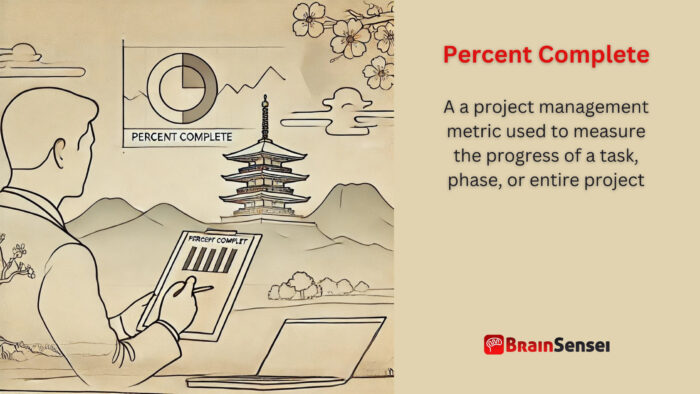
Percent Complete
What is Percent Complete?
Percent complete is a project management metric used to measure the progress of a task, phase, or entire project. It represents the proportion of work completed compared to the total work required, typically expressed as a percentage. This metric helps project managers assess performance, forecast completion, and ensure projects stay on track.
Key Takeaways
- Percent Complete quantifies project progress in percentage terms.
- It helps track performance and forecast project timelines.
- It is used in Earned Value Management (EVM) to analyze project health.
- Misreporting Percent Complete can lead to inaccurate project assessments.
- It is calculated using different methods, including effort-based and duration-based approaches.
Understanding Percent Complete
How It Works
Project managers commonly use and calculate Percent Complete in project tracking and performance evaluation using formulas based on effort, duration, or actual work. The most widely used approaches include:
- Effort-Based
Percent Complete = (Actual Work Performed / Total Work Required) x 100 - Duration-Based
Percent Complete = (Elapsed Time / Total Scheduled Time) x 100 - Cost-Based (Earned Value Methodology – EVM)
Percent Complete = (Earned Value (EV) / Budget at Completion (BAC)) x 100
Using these methods, project managers can accurately gauge project progress, identify potential delays, and make informed decisions to align the project with its goals.
Notes
- Subjectivity Risks: Manual estimation of Percent Complete can be inaccurate if subjective judgments are involved.
- Impact on Forecasting: Incorrect Percent Complete values can distort project forecasts and budget calculations.
- Milestone Alignment: Some teams only update Percent Complete upon milestone achievement.
- Automation: Project management software can automate Percent Complete tracking, reducing errors.
Related Terms
- Earned Value (EV): A measure of work performed, expressed in monetary value, to evaluate project progress.
- Planned Value (PV): The authorized, time-phased budget assigned to complete scheduled work.
- Schedule Performance Index (SPI): A project management metric that indicates schedule efficiency using EV and PV.
- Work Breakdown Structure (WBS): A hierarchical decomposition of work to structure project tasks.
- Estimate at Completion (EAC): A forecast of total project cost based on current performance trends.
Examples of Percent Complete in Different Industries
Construction Industry
A construction firm is building a commercial office complex. The team completed half of the construction tasks by the 6-month mark of the 12-month project schedule. Using a duration-based, the calculated percentage completed is:
(6 / 12) x 100 = 50%
However, only 40% of the planned work has been completed upon reviewing the cost and labour effort, revealing a potential delay. This discrepancy prompts the project manager to investigate workforce availability, supply chain disruptions, and unforeseen site conditions. Adjustments to the project plan, such as resource reallocation or additional labour, are made to align progress with expectations.
Additionally, the project manager leverages Earned Value Management (EVM) to track financial performance. If the Earned Value (EV) is $5 million while the Budget at Completion (BAC) is $12 million, the revised percentage completed using EVM is:
(5 / 12) x 100 = 41.67%
The calculated amount indicates that the project is slightly behind schedule and requires corrective action.
IT and Software Development
A software company is developing a mobile application. The project comprises five major development phases, contributing 20% to the total work. After completing three stages, the percentage completed is:
(3 / 5) x 100 = 60%
While the percentage suggests steady progress, the development team encounters unexpected challenges, such as integrating third-party APIs and fixing critical bugs. These unforeseen tasks increase effort and require additional time, impacting the actual Percent Complete.
To improve tracking accuracy, the project manager breaks down each phase further using Agile sprints. The project manager calculated a more accurate Percent Complete by measuring story points completed relative to the total planned points. If the team scheduled for 120 story points and finished 72, the revised percentage completed is:
(72 /120) x 100 = 60%
This granular approach ensures transparency in tracking progress and identifying roadblocks early.
Aerospace & Defense
An aerospace company is manufacturing a satellite. The project has several phases, including design, component manufacturing, assembly, and testing. The company uses Earned Value Management (EVM) to track the Percent Complete.
The Earned Value (EV) is $8 million at the midway point, while the Budget at Completion (BAC) is $10 million. Using EVM, the percentage completed is:
(8 / 10) x 100 = 80%
Although this indicates significant progress, the team faces an issue during the integration phase due to a critical design flaw that requires rework. This setback affects the schedule and budget, reducing the accuracy of project completion.
The project team implements continuous monitoring and simulation-based testing to mitigate such risks. By leveraging real-time performance metrics and contingency planning, the team ensures it meets the final launch date with minimal delays.
These industry-specific examples demonstrate how various sectors apply Percent Complete. Accurate progress tracking ensures successful project delivery in construction, IT, or aerospace.
Use Cases of Percent Complete
United States (Infrastructure Development)
A large-scale highway expansion project in the United States requires meticulous progress tracking to ensure timely completion. In collaboration with construction firms, the state government uses Percent Complete to assess progress and allocate funding. By leveraging Earned Value Management (EVM), project managers ensure that the work aligns with planned budgets and timelines. For instance, if the budget at completion (BAC) is $500 million and the earned value (EV) at the halfway point is $220 million, the percentage completed is calculated as:
(220 / 500) x 100 = 44%
Despite being at the midpoint, the progress suggests a lag, prompting resource reallocation and schedule adjustments. Project managers can proactively address delays and maintain stakeholder confidence by regularly updating Percent Complete.
Germany (Renewable Energy)
A wind farm project in Germany employs Percent Complete tracking to monitor turbine installation and forecast energy production milestones. With 100 turbines scheduled for installation over two years, project managers set progress thresholds based on completion percentages. If the team installs 40 turbines by the end of the first year, the percentage completed is:
(40 / 100) x 100 = 40%
However, project managers factor in site preparation and grid connection milestones to improve accuracy. If only 30 turbines are grid-connected, the authentic Percent Complete may be lower. This difference in the number of turbines installed versus grid-connected prompts teams to accelerate grid-connection efforts while ensuring compliance with safety regulations and environmental standards.
Japan (Manufacturing)
An automotive factory in Japan utilizes Percent Complete to monitor production line efficiency. The factory schedules a new electric vehicle (EV) model for mass production, with assembly phases including component manufacturing, chassis assembly, and final inspection. If they fully assemble 1,500 cars out of a 5,000-unit target, the initial percentage completed estimate is:
(1500 / 5000) x 100 = 30%
However, upon reviewing quality control metrics, only 1,200 vehicles passed the final inspection, reducing the actual percentage complete. This reduction prompts factory managers to optimize assembly line processes and increase workforce training to minimize defects. Tracking the Percent Complete at various production stages ensures the project meets market launch deadlines.
These use cases demonstrate how Percent Complete applies across industries, ensuring projects remain on schedule and within budget. Accurate tracking minimizes risks, improves forecasting, and enhances decision-making for project success.
Best Practices for Using Percent Complete
Establish Clear Criteria for Measurement
A project team should define standardized methods for calculating Percent Complete. Consistency ensures accurate reporting using effort-based, duration-based, or cost-based approaches. For example, defining completion criteria for user stories is essential if a software development team tracks Percent Complete using Agile sprints.
Update Percent Complete Regularly
Projects evolve rapidly, and progress tracking must reflect real-time conditions. Weekly or bi-weekly updates help prevent outdated assessments. Using project management software such as Microsoft Project, Jira, or Primavera P6 automates updates and minimizes manual errors.
Validate with Earned Value Management (EVM)
Percent Complete alone does not always provide a comprehensive picture. By integrating Earned Value (EV) and Planned Value (PV), project managers can assess performance against budget and timeline constraints. A project reporting 75% completion might appear on track, but corrective actions may be required if the Earned Value (EV) is significantly lower than the Planned Value (PV).
Cross-Check with Milestone Completion
Breaking down projects into phases with milestone-based tracking improves accuracy. A construction project might be 60% complete in duration but only 45% complete in actual work completed. Project managers can avoid misleading progress estimates by aligning the percent complete with project milestones.
Use Visual Dashboards for Better Tracking
Data visualization enhances project transparency. Gantt charts, burndown charts, and dashboards with real-time Percent Complete indicators help teams and stakeholders make informed decisions. Tools such as Power BI, Tableau, and Smartsheet offer customizable visual tracking solutions.
Ensure Team Alignment and Accountability
Project team members must agree on reporting standards. Regular progress review meetings ensure that the reported Percent Complete reflects actual progress. Additionally, incorporating accountability frameworks like RACI (Responsible, Accountable, Consulted, Informed) prevents discrepancies in reporting.
Anticipate and Adjust for Variances
Projects rarely go exactly as planned. Variances in scope, unexpected risks, or resource constraints can impact Percent Complete calculations. Project managers should anticipate such variations and incorporate buffer periods to adjust progress estimates accordingly.
Avoid Over-Reliance on Subjective Estimates
Some teams report Percent Complete based on “gut feeling” rather than quantifiable data. This practice introduces the risk of overly optimistic or pessimistic assessments. Teams reduce subjectivity by measuring progress on actual deliverables, logged work hours, or financial performance.
Leverage Historical Data for Better Forecasting
Analyzing past project performance helps set realistic Percent-Complete expectations. If a similar project experiences a slowdown during the integration phase, the current project can proactively allocate additional resources.
Automate Percent Complete Tracking Where Possible
With advancements in AI and data analytics, many project management tools now offer predictive tracking. Automating Percent Complete calculations through sensors, IoT devices, or machine learning algorithms can enhance accuracy in industries like construction and manufacturing.
Continuous Training and Process Improvement
Organizations should train project managers and team members on effective progress-tracking methodologies. Regular process reviews help refine Percent Complete calculations, ensuring they align with industry best practices.
By following these best practices, organizations can improve the accuracy of Percent Complete calculations, mitigate project risks, and enhance overall project success.
Common Mistakes and Issues
Overestimating Percent Complete
Teams make one of the most common mistakes in project management when they overestimate the Percent Complete. They often report progress based on time elapsed rather than actual work completed. For example, a software development project might have a six-month schedule; the team might assume 50% completion at the three-month mark. However, if significant functionalities remain incomplete, they will find the authentic Percent Complete is much lower. Overestimation leads to unrealistic forecasting and project delays.
Underestimating Scope Complexity
Another common issue arises when teams fail to account for project complexity. For example, early stages such as site preparation and foundation work may progress quickly in construction projects, leading to a misleadingly high Percent Complete. However, later stages, such as finishing work and compliance checks, may take significantly longer. Percent Complete values may create a false sense of progress without proper scope assessment.
Failure to Integrate Earned Value Management (EVM)
Some project managers rely solely on time—or effort-based calculations without considering financial performance. Earned Value Management (EVM) integrates cost metrics to provide a more comprehensive picture. For example, a project showing 70% completion in time might only be 50% complete regarding budgeted costs, indicating potential inefficiencies or misallocations. Failing to incorporate EVM can result in misleading progress reports.
Inconsistent Data Reporting
Project teams often have multiple stakeholders providing input on progress tracking. If different team members use varying criteria to assess Percent Complete, inconsistencies can arise. For example, one team might count partially completed tasks toward progress, while another only considers fully completed deliverables. Standardized measurement criteria and automated reporting tools can help mitigate this issue.
Lack of Contingency Planning
Projects rarely proceed precisely as planned. Unexpected delays, scope changes, and resource constraints affect the Percent Complete calculations. Projects may appear on track without built-in contingency measures until a sudden setback disrupts completion timelines. Risk management strategies should include buffer periods and contingency plans to accommodate unforeseen issues.
Ignoring Quality Factors
Some teams report Percent Complete based solely on deliverable count without considering quality. In manufacturing, for instance, producing 1,000 units does not necessarily mean the project is 100% complete if 200 fail quality inspection. To ensure accuracy, Percent Complete should incorporate quality assurance metrics.
Best Practices for Avoiding These Mistakes
- Use multiple tracking methods: Combining time, cost, and effort-based calculations provides a well-rounded assessment.
- Set clear progress benchmarks: Define completion criteria for different project phases.
- Conduct regular project reviews: Frequent progress assessments help identify and correct misreported Percent Complete values.
- Automate tracking where possible: Using project management tools reduces human error and ensures consistency.
- Account for quality control: Ensure completed work meets required standards before including it in Percent Complete calculations.
- Train teams on accurate reporting: Educating team members on proper tracking methodologies minimizes reporting errors.
By recognizing and addressing these common mistakes, project managers can ensure that the Percent Complete reflects an accurate and realistic measure of project progress. This practice will lead to better decision-making and successful project delivery.
Frequently Asked Questions (FAQs)
Can Percent Complete be estimated manually?
Yes, but manual estimation is prone to bias and errors. Project teams should use it alongside objective tracking methods like Earned Value Analysis.
What happens when teams overestimate Percent Complete?
Overestimating Percent Complete can result in inaccurate project forecasting, unexpected delays, and budget overruns.
Does Percent Complete account for task complexity?
No, unless teams use effort-based tracking. Duration-based methods may not accurately reflect complex or high-effort tasks.
How often should teams update Percent Complete?
Teams should update Percent Complete regularly—weekly or bi-weekly in most projects—to ensure accurate tracking.
Which industries use Percent Complete tracking the most?
Construction, IT, aerospace, manufacturing, and government projects rely heavily on Percent Complete tracking to manage large-scale projects.
Additional Resources
Preparing for a PMI certification?
- Exam Prep Courses: PMP®, CAPM®, and PMI-ACP®
- Exam Simulators: PMP®, CAPM®, PMI-ACP®, PMI-PBA®, PMI-RMP®, PMI-SP®, PgMP®, and PfMP®
- Professional Development Units (PDUs): 15, 30, and 60 PDU Bundles



